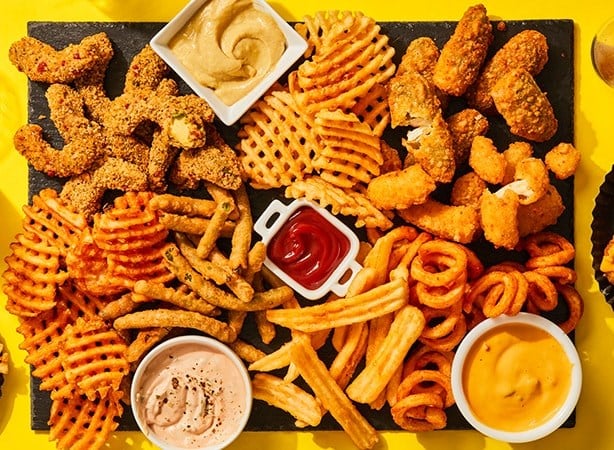
Restaurants need to address legacy costs and eliminate items that don’t boost sales and profits.
Operators have been streamlining their menus to focus on items best suited for takeout and delivery, while at the same time seeking to minimize their costs for inventory and production.
Simplified menus that utilize versatile ingredients had been gaining traction even before the COVID-19 crisis. But they have become even more important now that driving down costs is critical to survival. Operating with simplified menus also allows restaurants to work with a reduced staff, as many operators have had to adjust their labor models either because of reduced revenues or to maintain social distancing in their facilities.

“The first step to rationalizing and optimizing a menu is to take a look at share of sales and share of profits,” says Maeve Webster, president of consulting firm Menu Matters. “Any items low on both should immediately be axed. Items not driving sales and contributing little to profitability are taking time and focus away from the items that do.”
Operators should also evaluate their ingredients and products according to how well they maintain their integrity in the delivery process, she says.
If there are good ingredient substitutions that won't alter the fundamental characteristics of an item but will travel much better—and are easy to source and don't significantly negatively impact the profitability—then that should be “an easy first step,” Webster says.
“Overall, a streamlined menu will work much better operationally for takeout/delivery because it ensures everything going out the door is excellent quality and working to increase patron loyalty, visitation and spend,” she says.

“Overall, a streamlined menu will work much better operationally for takeout/delivery because it ensures everything going out the door is excellent quality,”
Evaluating Menu Items
At Mellow Mushroom, the Atlanta-based pizza and sandwich chain, the company had already been conducting an analysis of which menu items were best suited for its online ordering platform, as that has been a growth focus for the chain.
“We had already identified some of the categories of products and some individual menu items that either were not being ordered online very extensively, or just didn’t travel well,” says Anne Mejia, vice president of brand development at Mellow Mushroom. “So six weeks ago, we went through the list and said, ‘These items weren’t working anyway, so let’s just make those decisions quickly.’”
The company carefully examined slower-moving items and dishes that require extra labor, and gave its franchises the option to remove those items from the menu through mid-May. It also looked at some unique produce items that were used minimally, such as in a single type of salad, and revamped the recipes of those salads to eliminate those items.
“We said we are going to make our salads a different way during this period of time, just so operators don’t have to bring in individual SKUs of items,” says Mejia. “We don’t want them spending money on food that they can’t sell.”

“We don’t want them spending money on food that they can’t sell."
Cross-Utilization of Ingredients
The sales pressures that operators may have to face for months to come must be met with sharp cost-cutting measures. One of the proven ways to achieve cost reductions is through the cross-utilization of ingredients. This strategy eliminates waste of seldom-used items, creates opportunities to purchase fewer items in larger quantities and simplifies inventory management.

In addition, featuring the same ingredients in multiple recipes can create labor efficiencies and minimize training requirements as staff become familiar with individual recipe components. Familiar ingredients may also be comforting to consumers at this time, says Webster.
“Consumers will be looking for consistency in the face of a prolonged period of anxiety and uncertainty,” she says.
Operators could develop a simple menu of five or six items that maintain their integrity during takeout and delivery.
New Menu Items
As operators revamp their menus to optimize for what may be a prolonged period of consumer interest in takeout and delivery, they should probably not stray far from their core competencies, says Ray Camillo, CEO and funder of Blue Orbit Restaurant Consulting.
“I don’t think a pizza restaurant should start selling sushi for takeout,” he says.
However, there may be opportunities for operators to offer items that travel well that were not a part of their traditional dine-in menus, Camillo says. For example, a high-end steakhouse might be wary of sending an expensive, dry-aged rib-eye out in a cardboard box, but perhaps it could leverage the trust consumers have in its brand to create more mid-scale items that travel well.
“Maybe they could sell the most incredible lasagna or the most incredible cassoulet to go, for the whole family,” he says. “They could say, ‘You trust us with your steak, you can trust us with your lasagna, and it’s only $23 for a lasagna for six people.’”
Operators could develop a simple menu of five or six items that maintain their integrity during takeout and delivery, and reflect well on their brand. It could be posted on their website and social media as the temporary menu while the dining room is closed.
“I think consumers would support that and rally around it,” says Camillo.
Operators will need to address their legacy cost structures in multiple ways as they seek to revive their businesses during the pandemic and eventual recovery. Evaluating existing recipes and ingredients to eliminate those items that don’t contribute to both the top and bottom line is one of the strategies that can help.

Operators could develop a simple menu of five or six items that maintain their integrity during takeout and delivery.

